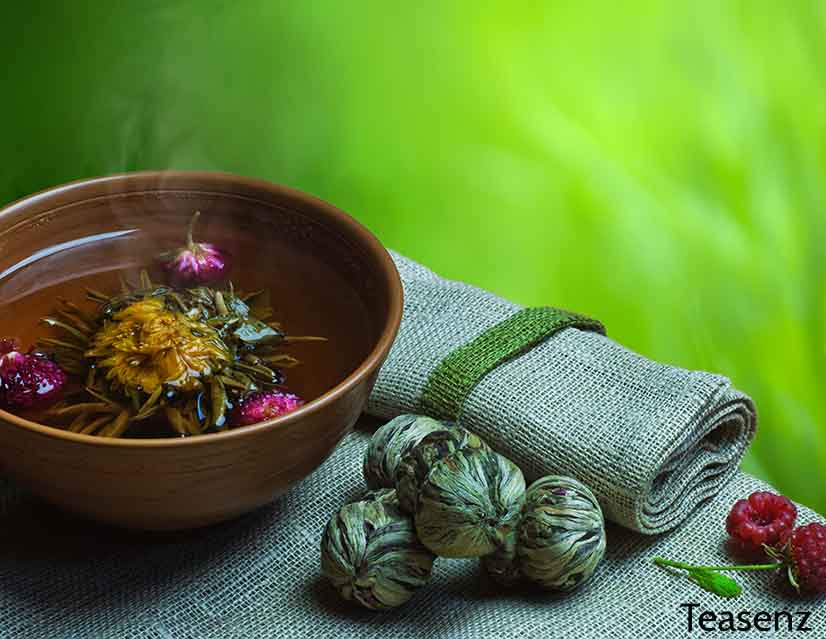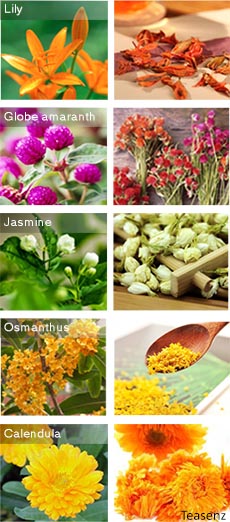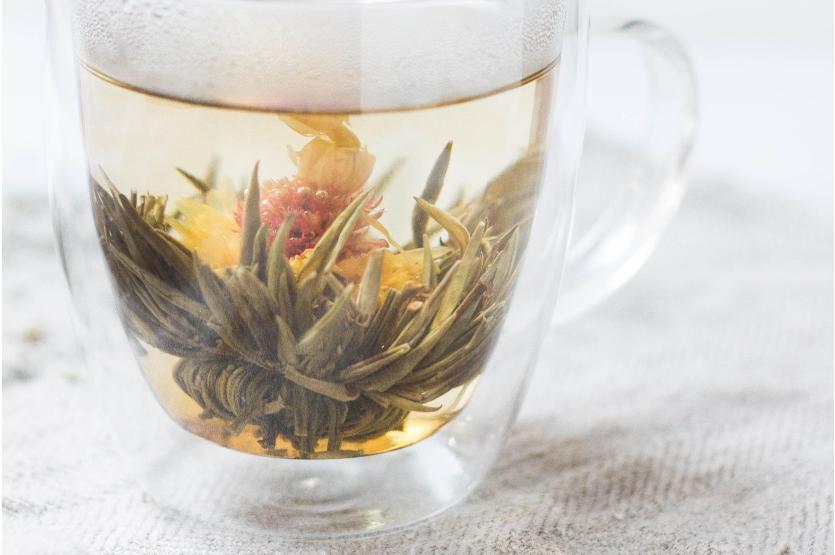Blooming tea, also popularly known as flowering tea, traces its origins from China. They are a special kind of tea made from a combination of tea leaves and medicinal flowers. Leaves and flowers are stitched together and unfurl beautifully when infused in hot water. Hence, blooming teas are enjoyed for their taste and aesthetic form.
While the health benefits of green, white, and oolong tea have been extensively researched in the past decade, this can't be said for blooming tea. The main reason for this is because these tea blooms are made from multiple ingredients. Therefore, we need to understand the benefit of each ingredient which are potentially used in blooming teas.
In this article, we will each ingredients used in making these charming flower balls and discuss their respective health benefits.

Blooming/Flowering Tea Versus Traditional Tea & Tisanes
Before we discuss the benefits of blooming tea, we first need to understand the difference between tea, tisanes and blooming teas:
- Tea is the result of steeping processed leaves of a particular plant scientifically known as Camellia Sinensis. For example white tea, black tea, and oolong tea are made from this plant.
- Tisanes are beverages resulting from steeping flowers or other herbs, such as Chrysanthemum and Rooibos. However, in practice the term 'tea' is still most widely used instead of tisanes.
- Blooming tea: It wasn't until only recently when a new type of tea came to take the limelight: blooming tea. As opposed to the traditional tea and tisanes, this type of tea is an interesting combination of leaves and different flower types including osmanthus, jasmine, lily, marigold/calendula, and globe amaranth. They are tea leaves and flowers skilfully bound together with cotton threads into bundles designed to gracefully unfurl into charming art shapes when brewed. This process greatly resembles the 'blooming' of a flower, explaining its name.
Green Tea: The Health Benefits
The main ingredient of blooming teas are green tea leaves. Since ancient times, the Chinese have known about its medicinal values, having used it to treat almost everything from a simple headache to infections. Scientific research and studies have been conducted from across the world to provide evidence for the health benefits that have long been associated with drinking green tea. Below the main benefits are listed (if you know already about green tea health benefits, then scroll down directly for the benefits of flowers used in blooming teas):
- Antioxidant properties: Loaded with polyphenols such as catechins and flavonoids, green tea considerably reduces the formation of free radicals in the body, providing significant protection for the skin cells against the ravaging effects of pollution, helping delay aging, and preventing the development of other age-related disorders and diseases.
- Improve metabolism and induce fat burning: Check out any fat-burning supplement, and you are sure to find green tea in the list of ingredients. Studies have somehow attributed this to the caffeine content of green tea that has shown to enhance physical performance by mobilizing fatty acids and making them useable as body energy.
- Helps to prevents cancer: Because of its powerful antioxidant properties, green tea helps reduce one's risk of developing various types of cancer including breast cancer, colorectal cancer, prostate cancer, etc. Cancer is basically the uncontrolled growth of cells, an activity that is strongly thwarted by antioxidants.1
- Relieve stress: Green tea is rich in amino acids including theanine, which is believed to provide a tranquilizing and relaxing effect that helps reduce stress and prevents one from getting depressed.
- Lowers the risk of cardiovascular diseases: Proven to lower one's total cholesterol, triglycerides, and LDL cholesterol, green tea protects oxidation of the LDL cholesterol particles, lowering one's risk of cardiovascular disease.
- Green tea lowers the risk of dental infection: Biological effects of the catechins in green tea include inhibiting bacterial and viral activities in the mouth, lowering your risks of infection. This likewise translates to lower risks of caries and elimination of bad breath.
- Lowers the risk of neurodegenerative disorders: Research have shown that the bioactive catechin compounds in green tea have many protective effects on neurons, potentially reducing the risk of both Parkinson's and Alzheimer's diseases.
Sometimes, white tea leaves are used instead of green tea. The health properties of both teas are fairly similar. For more detailed discussion about the differences you can visit this page: Green Tea vs White Tea.
The Health Benefits Of Flowers Used In Blooming Tea

Besides high grade green tea leaves, Teasenz' flowering tea also uses selected nutritious dried flowers that can be also appreciated for its appearance. With different flowers used,
different types of flowering teas will have varying health benefits. Now let's take a closer look at why these dehydrated flowers can be healthy for you:
- Lily has long been part of traditional Chinese medical science and has been a mainstay in many popular beauty products. A well-known flower tea ingredient for its graceful appearance, lily significantly contributes to health and wellness as it helps soothe the nerves, keep the lungs moist, alleviate cough, clear heat of the heart, and cure insomnia to some degree. Lily flower is often used in the lower parts of the blooming tea, due to this relatively large size.
- Jasmine flowers have a very calming aroma that helps against high blood pressure and relaxing the nerve system. It has anti-bacterial properties that prevents bad breath and prevents decay of tooth. Last but not least, jasmine flowers are great for skin which is why there are often found in oils and lotions for aromatherapy (for dry skin or sunburn).
- Because of its anti-inflammatory, antibacterial, and antiseptic properties, marigold (also known as calendula) is popularly steeped as a tisane as it helps nourish the liver, eliminates toxins, promotes better digestion, beautifies the skin, enhances visual acuity, and removes body heat. Marigold (Calendula Officinalis) should not however be confused with the Arnica marigold, which is toxic.
- Dried osmanthus flowers infused with tea have a long list of health benefits such that it helps enhance one's complexion and delay the effects of aging because of its antioxidant properties. Also used to make wine and cake, osmanthus is proven to relieve chills, alleviate pains, and warm the lungs and stomach. Osmanthus flower are too small to be stitched together with other flowers. Instead they are added to the blooming tea when they're rolled in bulbs. When the tea bloom is infused, the little osmanthus flowers will appear and float to the surface.
- Globe Amaranth is another flower you often see in tea blooms. In Chinese Traditional Medicine (TCM) herbal teas with Globe Amaranth helps eliminate phlegm, prevent asthma and shortness of breath, relieve cough and its symptoms, clean the liver, releasing tension, and enhances vision. This flower often times is the last flower on top of the blooming tea once it's unfurled.
- To a lesser extend we also sometimes see Hibiscus flowers being used in blooming tea. However, due to the release of a lot of colour, you can't enjoy the view of the flowering tea as good as you should. Hence, we're not a fan of using Hibiscus flowers. However, it is a very healthy flower, with great properties against inflammation, high blood pressure, and cholesterol.
Teasenz offers a wide collection of blooming teas at wholesale prices. Click the following link to discover their unique appearances: blooming tea.
If you want to learn more about how to steep these beautiful tea flowers yourself to let it unfurl perfectly than make sure to read the following guide: how to steep blooming tea.
References:
- Green Tea and Cancer Prevention, Nutrition and Cancer, 2010.
- An update on the health benefits promoted by edible flowers and involved mechanisms, Food Chemistry, 2021.
